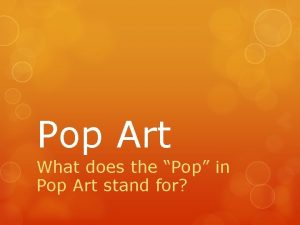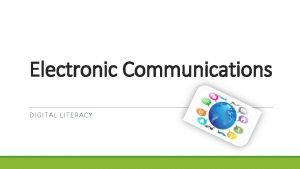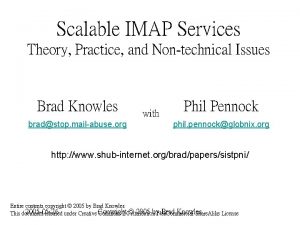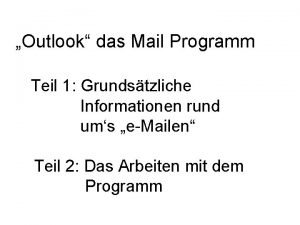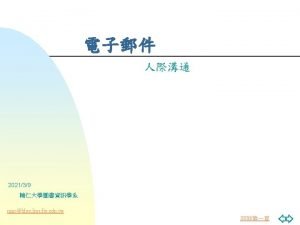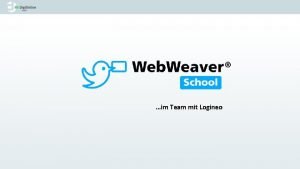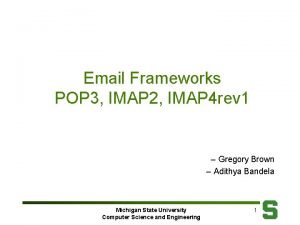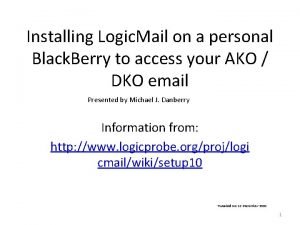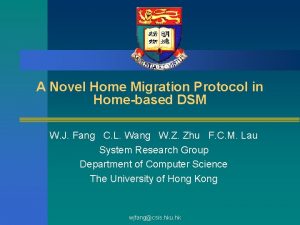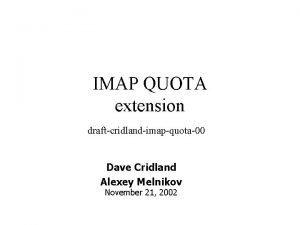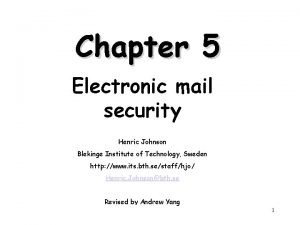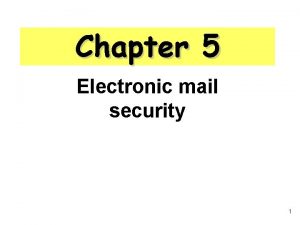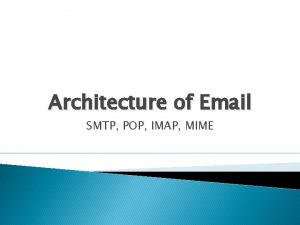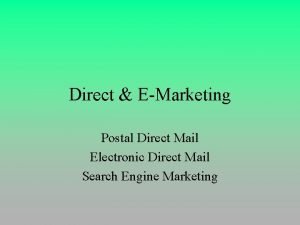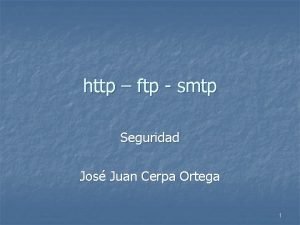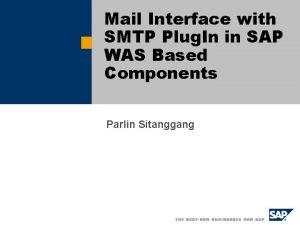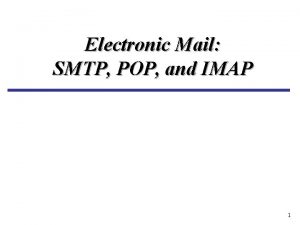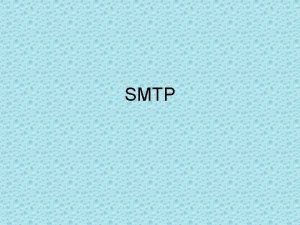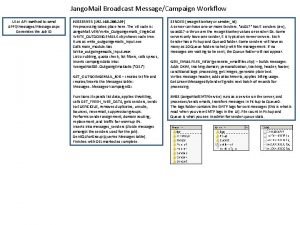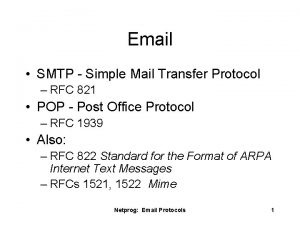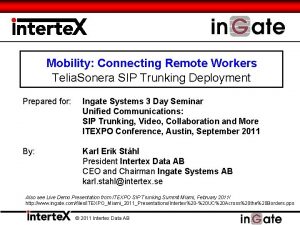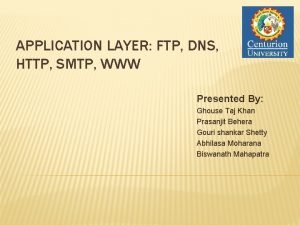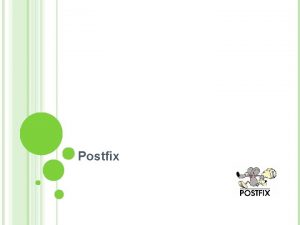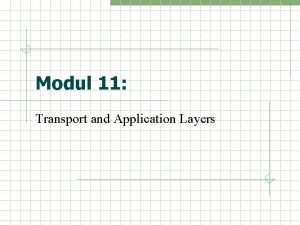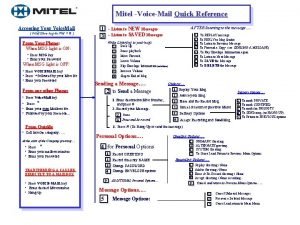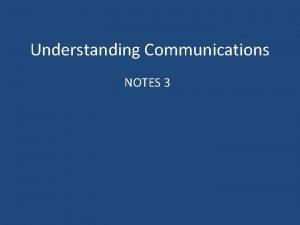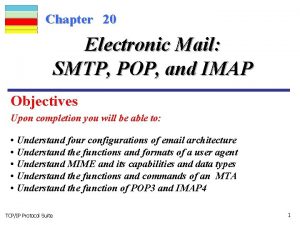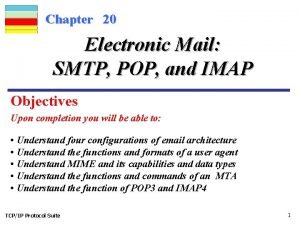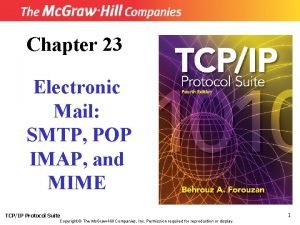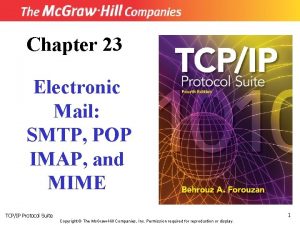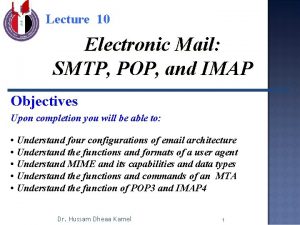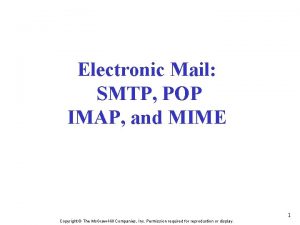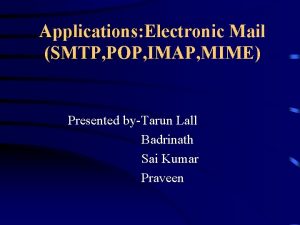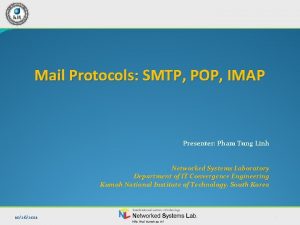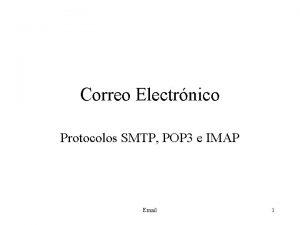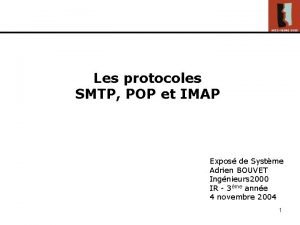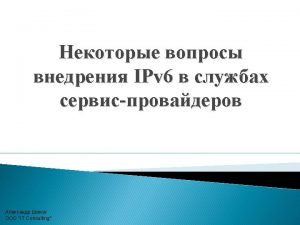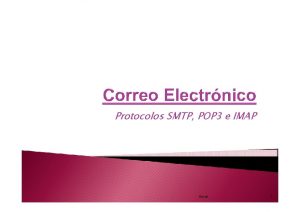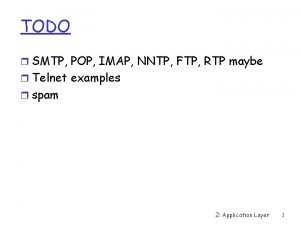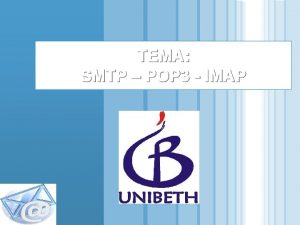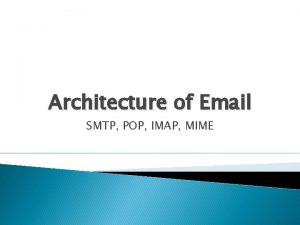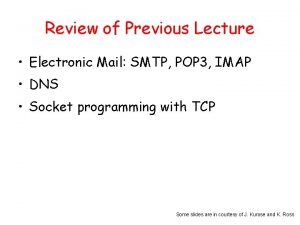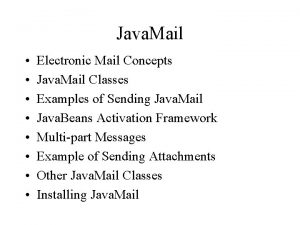Chapter 23 Electronic Mail SMTP POP and IMAP










































- Slides: 42

Chapter 23 Electronic Mail: SMTP, POP, and IMAP Objectives Upon completion will be able to: • Understand fouryou configurations of email architecture • Understand the functions and formats of a user agent • Understand MIME and its capabilities and data types • Understand the functions and commands of an MTA • Understand the function of POP 3 and IMAP 4 • Quiz Processing URL • Reference • http: //www. mikeownage. com/mike/ebooks/TDC 463. pdf TCP/IP Protocol Suite 1

20. 1 ARCHITECTURE To explain the architecture of email, we give four scenarios. We begin with the simplest situation and add complexity as we proceed. The fourth scenario is the most common in the exchange of email. The topics discussed in this section include: First Scenario Second Scenario Third Scenario Fourth Scenario TCP/IP Protocol Suite 2

Figure 20. 1 TCP/IP Protocol Suite First scenario 3

Note: When the sender and the receiver of an email are on the same system, we need only two user agents. TCP/IP Protocol Suite 4

Figure 20. 2 TCP/IP Protocol Suite Second scenario 5

Note: When the sender and the receiver of an email are on different systems, we need two UAs and a pair of MTAs (client and server). TCP/IP Protocol Suite 6

Figure 20. 3 TCP/IP Protocol Suite Third scenario 7

Note: When the sender is connected to the mail server via a LAN or a WAN, we need two UAs and two pairs of MTAs (client and server). TCP/IP Protocol Suite 8

Figure 20. 4 TCP/IP Protocol Suite Fourth scenario 9

Figure 20. 5 TCP/IP Protocol Suite Push vs. pull 10

Note: When both sender and receiver are connected to the mail server via a LAN or a WAN, we need two UAs, two pairs of MTAs (client and server), and a pair of MAAs (client and server). This is the most common situation today. TCP/IP Protocol Suite 11

20. 2 USER AGENT The user agent (UA) provides service to the user to make the process of sending and receiving a message easier. The topics discussed in this section include: Services Provided by a User Agent Types Sending Mail Receiving Mail Addresses Mailing List MIME TCP/IP Protocol Suite 12

Figure 20. 6 TCP/IP Protocol Suite User agent 13

Note: Some examples of command-driven user agents are mail, pine, and elm TCP/IP Protocol Suite 14

Note: Some examples of GUI-based user agents are Eudora, Outlook, and Netscape. TCP/IP Protocol Suite 15

Figure 20. 7 TCP/IP Protocol Suite Format of an email 16

Figure 20. 8 TCP/IP Protocol Suite Email address 17

Figure 20. 9 TCP/IP Protocol Suite MIME 18

Figure 20. 10 TCP/IP Protocol Suite MIME header 19

Table 20. 1 Data types and subtypes in MIME TCP/IP Protocol Suite 20

Table 20. 1 Data types and subtypes in MIME (Continued) TCP/IP Protocol Suite 21

Table 20. 2 Content-transfer-encoding TCP/IP Protocol Suite 22

Figure 20. 11 TCP/IP Protocol Suite Base 64 23

Table 20. 3 Base 64 encoding table TCP/IP Protocol Suite 24

Figure 20. 12 TCP/IP Protocol Suite Quoted-printable 25

20. 3 MESSAGE TRANSFER AGENT: SMTP The actual mail transfer requires message transfer agents (MTAs). The protocol that defines the MTA client and server in the Internet is called Simple Mail Transfer Protocol (SMTP). The topics discussed in this section include: Commands and Responses Mail Transfer Phases TCP/IP Protocol Suite 26

Figure 20. 13 TCP/IP Protocol Suite SMTP range 27

Figure 20. 14 TCP/IP Protocol Suite Commands and responses 28

Figure 20. 15 TCP/IP Protocol Suite Command format 29

Table 20. 4 Commands TCP/IP Protocol Suite 30

Table 20. 5 Responses TCP/IP Protocol Suite 31

Table 20. 5 Responses (Continued) TCP/IP Protocol Suite 32

Figure 20. 16 TCP/IP Protocol Suite Connection establishment 33

Figure 20. 17 TCP/IP Protocol Suite Message transfer 34

Figure 20. 18 TCP/IP Protocol Suite Connection termination 35

Example 1 Let us see how we can directly use SMTP to send an email and simulate the commands and responses we described in this section. We use TELNET to log into port 25 (the well-known port for SMTP). We then use the commands directly to send an email. In this example, forouzanb@adelphia. net is sending an email to himself. The first few lines show TELNET trying to connect to the adelphia mail server. $ telnet mail. adelphia. net 25 Trying 68. 168. 78. 100. . . Connected to mail. adelphia. net (68. 168. 78. 100). After connection, we can type the SMTP commands and then receive the responses as shown below. We have shown the commands in black and the responses in color. Note that we have added for clarification some comment lines, designated by the “=” sign. These lines are not part of the email procedure. TCP/IP Protocol Suite 36

Example 1 (Continued) ========= Connection Establishment ======== 220 mta 13. adelphia. net SMTP server ready Fri, 6 Aug 2004. . . HELO mail. adelphia. net 250 mta 13. adelphia. net =========== Envelope ========== MAIL FROM: forouzanb@adelphia. net 250 Sender <forouzanb@adelphia. net> Ok RCPT TO: forouzanb@adelphia. net 250 Recipient <forouzanb@adelphia. net> Ok ========== Header and Body ========= DATA 354 Ok Send data ending with <CRLF> From: Forouzan TO: Forouzan This is a test message to show SMTP in action. TCP/IP Protocol Suite. 37

Example 1 (Continued) ======= Connection Termination======== 250 Message received: adelphia. net@mail. adelphia. net QUIT 221 mta 13. adelphia. net SMTP server closing connection Connection closed by foreign host. TCP/IP Protocol Suite 38

20. 4 MESSAGE ACCESS AGENT: POP AND IMAP The third stage of mail delivery uses a message access agent; the client must pull messages from the server. Currently two message access protocols are available: Post Office Protocol, version 3 (POP 3) and Internet Mail Access Protocol, version 4. The topics discussed in this section include: POP 3 IMAP 4 TCP/IP Protocol Suite 39

Figure 20. 19 TCP/IP Protocol Suite POP 3 and IMAP 4 40

Figure 20. 20 TCP/IP Protocol Suite POP 3 41

20. 5 WEB-BASED MAIL Some websites such as Hotmail and Yahoo provide email service to anyone who accesses the site. Mail transfer and retrieval requires the use of HTTP. TCP/IP Protocol Suite 42
 Smtp seznam.cz
Smtp seznam.cz Parallelism examples
Parallelism examples What does the pop in pop art stand for?
What does the pop in pop art stand for? Advantages and disadvantages of electronic mail
Advantages and disadvantages of electronic mail Electronic field production examples
Electronic field production examples Priority mail vs priority mail express
Priority mail vs priority mail express Google docshttps://mail.google.com/mail/u/0/#inbox
Google docshttps://mail.google.com/mail/u/0/#inbox Scalable imap
Scalable imap Hispeed imap einstellungen
Hispeed imap einstellungen Www.webmail.com correo
Www.webmail.com correo Courselets erstellen
Courselets erstellen Lern sax
Lern sax Imap2imap
Imap2imap Startlogic email settings
Startlogic email settings Imap hku
Imap hku Imap quota
Imap quota Imap terra outlook 2016
Imap terra outlook 2016 Kelebihan email dibanding surat biasa
Kelebihan email dibanding surat biasa E-mail singkatan dari… *
E-mail singkatan dari… * Electronic mail security in network security
Electronic mail security in network security Electronic mail security
Electronic mail security Electronic mail security
Electronic mail security Mime architecture
Mime architecture Electronic direct mail
Electronic direct mail Ftp and smtp
Ftp and smtp Is the electronic exchange of money or scrip
Is the electronic exchange of money or scrip Secure smtp control panel
Secure smtp control panel Sap smtp
Sap smtp Smtp vs snmp
Smtp vs snmp Rfc821
Rfc821 Smtp 220
Smtp 220 Jangomail login
Jangomail login Email protocol
Email protocol Office 365 header analyzer
Office 365 header analyzer Sonera smtp
Sonera smtp Smtp application layer
Smtp application layer Smtp.rcpttodomain
Smtp.rcpttodomain Smtp port
Smtp port Poczta vp.pl konfiguracja
Poczta vp.pl konfiguracja Smtp
Smtp Mitel smtp settings
Mitel smtp settings Smtp dna
Smtp dna Smtp voo
Smtp voo


